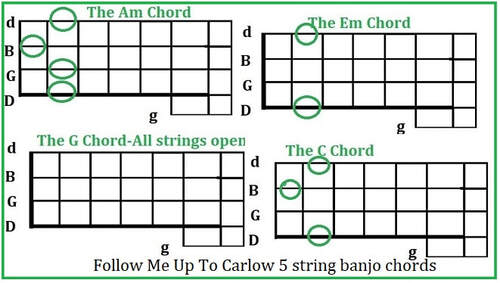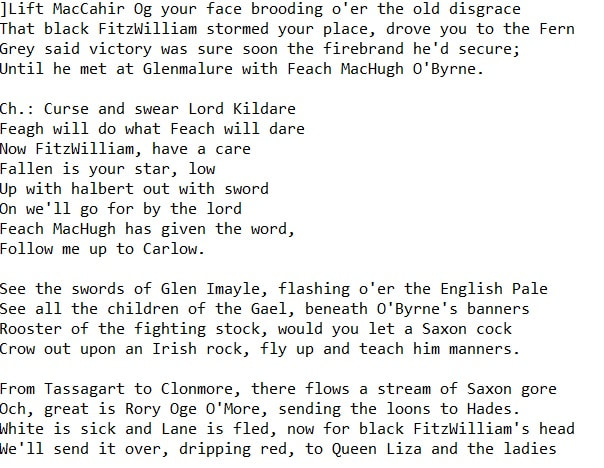Follow Me Up To Carlow, Lyrics And Guitar Chords
Follow Me Up To Carlow Irish folk / rebel song Lyrics And Guitar Chords. The sheet music and tin whistle notes are included for a D whistle. The five string banjo chords are also here along with the mandolin sheet music tab with lyrics. The song was written by Patrick Joseph McCall. Guitar chords in chordpro. In 1580 Fiach Mc O' Byrne completely overthrew the forces of the crown at ''The Pass Of Glen Malure'' in Wicklow. recorded by Planxty, Christy Moore along with The Young Dubliners, Paddy Reilly and Jim McCann. Irish rebel music. Recently recorded by Irish ballad group The High Kings on their new album Grace And Glory. The youtube video is by Irish singer Paddy Reilly who, by the way was the first to have a hit with The Fields Of Athenry Song all those years ago.
The third and forth verses were written by Alan Barrett
The third and forth verses were written by Alan Barrett
Follow Me Up To Carlow Song Lyrics & Chords In The Key Of Am
[Am] Lift MacCahir[Em] Og your face[Am] brooding o'er the[Em] old disgrace
That[Am] black FitzWilliam[Em] stormed your place, [C]drove you to the[Am] Fern
[Am]Grey said victor[Em]y was sure[Am] soon the firebrand[Em he'd secure;
Un[Am]til he met at[Em] Glenmalure with[C] Feach MacHugh O'[Am]Byrne.
Ch.:[Em] Curse and swear Lord Kildare
[G]Feagh will do what Feach will dare
[EmNow FitzWilliam, have a care
[G]Fallen is your[Am] star, low
[Em]Up with halbert out with sword
On[G] we'll go for by the lord
[Em]Feach MacHugh has given the word,
[G]Follow me up to[Am] Carlow.
See the swords of Glen Imayle, flashing o'er the English Pale
See all the children of the Gael, beneath O'Byrne's banners
Rooster of the fighting stock, would you let a Saxon cock
Crow out upon an Irish rock, fly up and teach him manners.
Ch.:[Em] Curse and swear Lord Kildare
[G]Feagh will do what Feach will dare
[EmNow FitzWilliam, have a care
[G]Fallen is your[Am] star, low
[Em]Up with halbert out with sword
On[G] we'll go for by the lord
[Em]Feach MacHugh has given the word,
[G]Follow me up to[Am] Carlow.
England’s power and pomp shall feel
Ireland’s justly vengeful steel,
While Fiach MacAodha is loath to kneel
Before a Tyrant’s throne!
The glen once more’s a battle-field:
Baile na Corra they’ll never yield!
Shield, blade and axe and spear they’ll wield
Until the day is won!
When Faith in Ireland mattered most,
James Baltlinglas joined Fiach’s host:
Then roused from slumber was the ghost
Of Art MacMurchadh-Caomhánach!
Six-thousand men that marched with Grey,
Like Colonel Moore, would find that day
Keen hidden Kerns who’d hack away
To quicken them back to Ráth Droma!
From Tassagart to Clonmore, there flows a stream of Saxon gore
Och, great is Rory Oge O'More, sending the loons to Hades.
White is sick and Lane is fled, now for black FitzWilliam's head
We'll send it over, dripping red, to Queen Liza and the ladies
[Am] Lift MacCahir[Em] Og your face[Am] brooding o'er the[Em] old disgrace
That[Am] black FitzWilliam[Em] stormed your place, [C]drove you to the[Am] Fern
[Am]Grey said victor[Em]y was sure[Am] soon the firebrand[Em he'd secure;
Un[Am]til he met at[Em] Glenmalure with[C] Feach MacHugh O'[Am]Byrne.
Ch.:[Em] Curse and swear Lord Kildare
[G]Feagh will do what Feach will dare
[EmNow FitzWilliam, have a care
[G]Fallen is your[Am] star, low
[Em]Up with halbert out with sword
On[G] we'll go for by the lord
[Em]Feach MacHugh has given the word,
[G]Follow me up to[Am] Carlow.
See the swords of Glen Imayle, flashing o'er the English Pale
See all the children of the Gael, beneath O'Byrne's banners
Rooster of the fighting stock, would you let a Saxon cock
Crow out upon an Irish rock, fly up and teach him manners.
Ch.:[Em] Curse and swear Lord Kildare
[G]Feagh will do what Feach will dare
[EmNow FitzWilliam, have a care
[G]Fallen is your[Am] star, low
[Em]Up with halbert out with sword
On[G] we'll go for by the lord
[Em]Feach MacHugh has given the word,
[G]Follow me up to[Am] Carlow.
England’s power and pomp shall feel
Ireland’s justly vengeful steel,
While Fiach MacAodha is loath to kneel
Before a Tyrant’s throne!
The glen once more’s a battle-field:
Baile na Corra they’ll never yield!
Shield, blade and axe and spear they’ll wield
Until the day is won!
When Faith in Ireland mattered most,
James Baltlinglas joined Fiach’s host:
Then roused from slumber was the ghost
Of Art MacMurchadh-Caomhánach!
Six-thousand men that marched with Grey,
Like Colonel Moore, would find that day
Keen hidden Kerns who’d hack away
To quicken them back to Ráth Droma!
From Tassagart to Clonmore, there flows a stream of Saxon gore
Och, great is Rory Oge O'More, sending the loons to Hades.
White is sick and Lane is fled, now for black FitzWilliam's head
We'll send it over, dripping red, to Queen Liza and the ladies
Alternative chords in the key of Dm for Follow Me Up To Carlow
Irish Lyrics And Chords C-F
[Dm] Lift MacCahir[Am] Og your face[Dm] brooding o'er the[Am] old disgrace
That[Dm] black FitzWilliam[Am] stormed your place, [F]drove you to the[Dm] Fern
[Dm]Grey said victor[Am]y was sure[Dm] soon the firebrand[Am] he'd secure;
Un[Dm]til he met at[Am] Glenmalure with[F] Feach MacHugh O'[Dm]Byrne.
Ch.:[Am] Curse and swear Lord Kildare
[C]Feagh will do what Feach will dare
[Am]Now FitzWilliam, have a care
[C]Fallen is your[Dm] star, low
[Am]Up with halbert out with sword
On[C] we'll go for by the lord
[Am]Feach MacHugh has given the word,
[C]Follow me up to[Dm] Carlow.
Irish Lyrics And Chords C-F
[Dm] Lift MacCahir[Am] Og your face[Dm] brooding o'er the[Am] old disgrace
That[Dm] black FitzWilliam[Am] stormed your place, [F]drove you to the[Dm] Fern
[Dm]Grey said victor[Am]y was sure[Dm] soon the firebrand[Am] he'd secure;
Un[Dm]til he met at[Am] Glenmalure with[F] Feach MacHugh O'[Dm]Byrne.
Ch.:[Am] Curse and swear Lord Kildare
[C]Feagh will do what Feach will dare
[Am]Now FitzWilliam, have a care
[C]Fallen is your[Dm] star, low
[Am]Up with halbert out with sword
On[C] we'll go for by the lord
[Am]Feach MacHugh has given the word,
[C]Follow me up to[Dm] Carlow.
Although the sheet music is in the key of Am, I have set the tin whistle notes to be played on a D whistle.
Follow me up to Carlow banjo mandolin tab with lyrics
Below is the ebook list of Irish Folk Songs with guitar chords
in 3 keys. Price €8.90 and I'll email the ebook after purchase .
The chords are suited to ukulele, banjo or mandolin also.
Martin
in 3 keys. Price €8.90 and I'll email the ebook after purchase .
The chords are suited to ukulele, banjo or mandolin also.
Martin
Music has always been a powerful medium to express emotions, ideas and stories. It has the ability to capture the essence of a historical event and evoke strong emotions in listeners. One such song is 'Follow Me Up To Carlow,' a traditional Irish folk song that has been passed down through generations. This song tells the story of a battle between the Irish rebels and the English army in the 16th century. It is a song that not only celebrates the bravery and resilience of the Irish people, but also serves as a reminder of the struggles and sacrifices made for their freedom.
Background
The song 'Follow Me Up To Carlow' is believed to have originated in the 19th century, during the Irish Rebellion of 1798. However, the events depicted in the song took place during the Battle of Glenmalure in 1580. The lyrics were written by the Irish poet and songwriter, Patrick Joseph McCall, who was known for his nationalist and patriotic themes in his work. The tune of the song is based on a traditional Irish melody, 'Fáinne Geal an Lae' (The Dawning of the Day).
Lyrics and Meaning
The song begins with the line 'Lift MacCahir Óg your face,' which refers to the leader of the Irish rebels, Fiach MacHugh O'Byrne. This line serves as a call to action for the Irish people to rise up and join the rebellion against the English. The lyrics go on to describe the events of the Battle of Glenmalure, where the Irish forces, led by O'Byrne, fought against the English army led by Lord Grey de Wilton.
The song celebrates the bravery and determination of the Irish rebels, who were vastly outnumbered by the English. The lyrics describe how the Irish 'turned and faced the foe' and fought fiercely, refusing to back down. The chorus of the song, 'Follow me up to Carlow,' serves as a rallying cry for the Irish people to join the fight and follow their leader to victory.
The song also highlights the hardships and sacrifices made by the Irish people during the rebellion. The line 'From Tassagart to Clonmore there flows a stream of Saxon gore' refers to the two towns where the battle took place, and the bloodshed that ensued. The lyrics also mention the loss of O'Byrne's son, who was killed in battle, symbolizing the personal sacrifices made by the rebel leader.
Symbolism and Significance
'Follow Me Up To Carlow' is more than just a song about a battle. It is a symbol of Irish resistance and resilience in the face of oppression. The lyrics speak of a united Ireland, fighting against a common enemy, and the importance of standing up for one's beliefs and freedom.
The song also serves as a reminder of the ongoing struggle for Irish independence. The rebellion of 1798 was just one of many uprisings against English rule, and 'Follow Me Up To Carlow' serves as a tribute to all those who fought and died for their country.
Furthermore, the song has been used as a symbol of Irish nationalism and pride. It has been recorded and performed by various artists, both in Ireland and abroad, and has become a staple in Irish folk music. The rousing chorus and powerful lyrics have made it a popular song to sing at political rallies and sporting events, further solidifying its significance in Irish culture.
Background
The song 'Follow Me Up To Carlow' is believed to have originated in the 19th century, during the Irish Rebellion of 1798. However, the events depicted in the song took place during the Battle of Glenmalure in 1580. The lyrics were written by the Irish poet and songwriter, Patrick Joseph McCall, who was known for his nationalist and patriotic themes in his work. The tune of the song is based on a traditional Irish melody, 'Fáinne Geal an Lae' (The Dawning of the Day).
Lyrics and Meaning
The song begins with the line 'Lift MacCahir Óg your face,' which refers to the leader of the Irish rebels, Fiach MacHugh O'Byrne. This line serves as a call to action for the Irish people to rise up and join the rebellion against the English. The lyrics go on to describe the events of the Battle of Glenmalure, where the Irish forces, led by O'Byrne, fought against the English army led by Lord Grey de Wilton.
The song celebrates the bravery and determination of the Irish rebels, who were vastly outnumbered by the English. The lyrics describe how the Irish 'turned and faced the foe' and fought fiercely, refusing to back down. The chorus of the song, 'Follow me up to Carlow,' serves as a rallying cry for the Irish people to join the fight and follow their leader to victory.
The song also highlights the hardships and sacrifices made by the Irish people during the rebellion. The line 'From Tassagart to Clonmore there flows a stream of Saxon gore' refers to the two towns where the battle took place, and the bloodshed that ensued. The lyrics also mention the loss of O'Byrne's son, who was killed in battle, symbolizing the personal sacrifices made by the rebel leader.
Symbolism and Significance
'Follow Me Up To Carlow' is more than just a song about a battle. It is a symbol of Irish resistance and resilience in the face of oppression. The lyrics speak of a united Ireland, fighting against a common enemy, and the importance of standing up for one's beliefs and freedom.
The song also serves as a reminder of the ongoing struggle for Irish independence. The rebellion of 1798 was just one of many uprisings against English rule, and 'Follow Me Up To Carlow' serves as a tribute to all those who fought and died for their country.
Furthermore, the song has been used as a symbol of Irish nationalism and pride. It has been recorded and performed by various artists, both in Ireland and abroad, and has become a staple in Irish folk music. The rousing chorus and powerful lyrics have made it a popular song to sing at political rallies and sporting events, further solidifying its significance in Irish culture.








